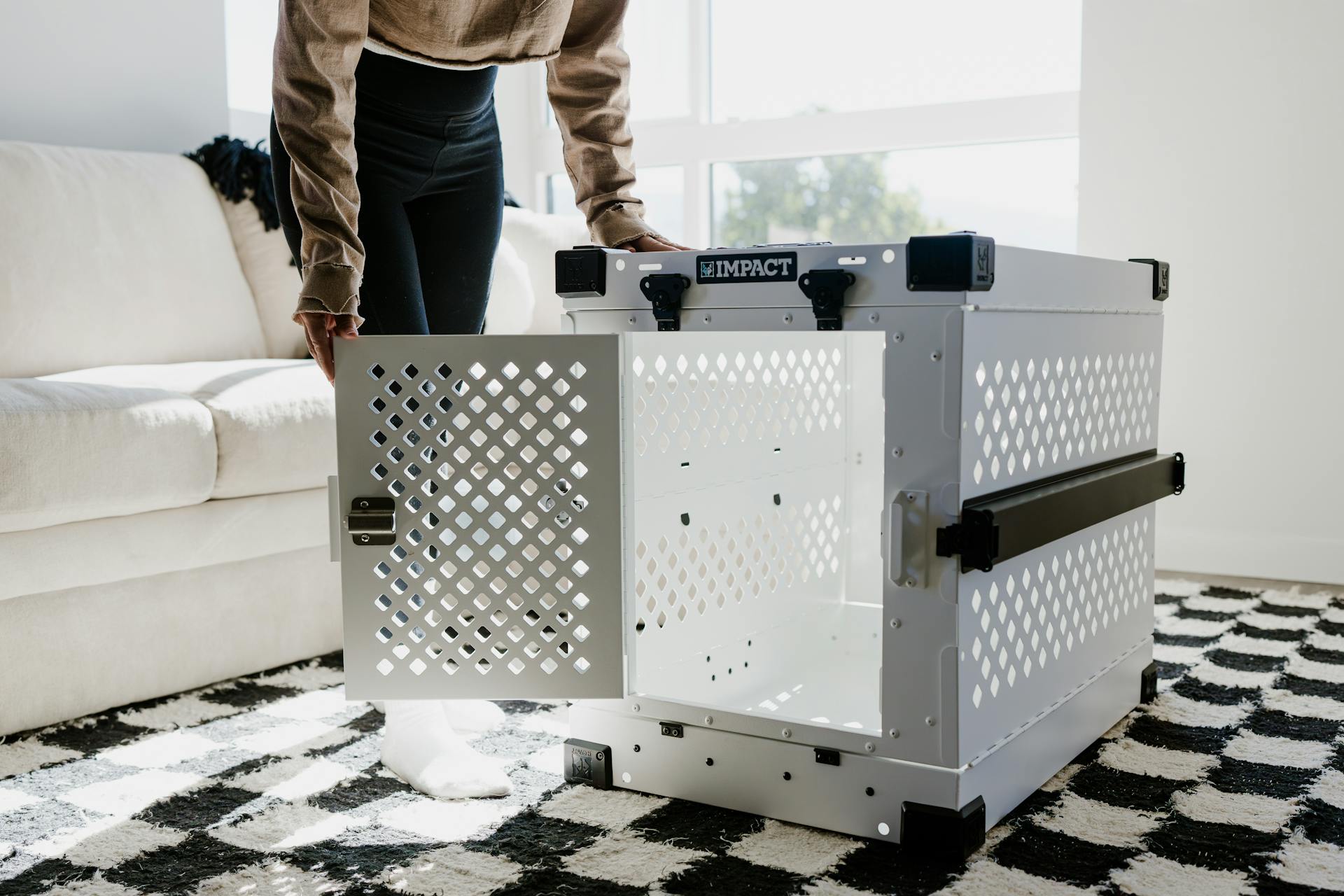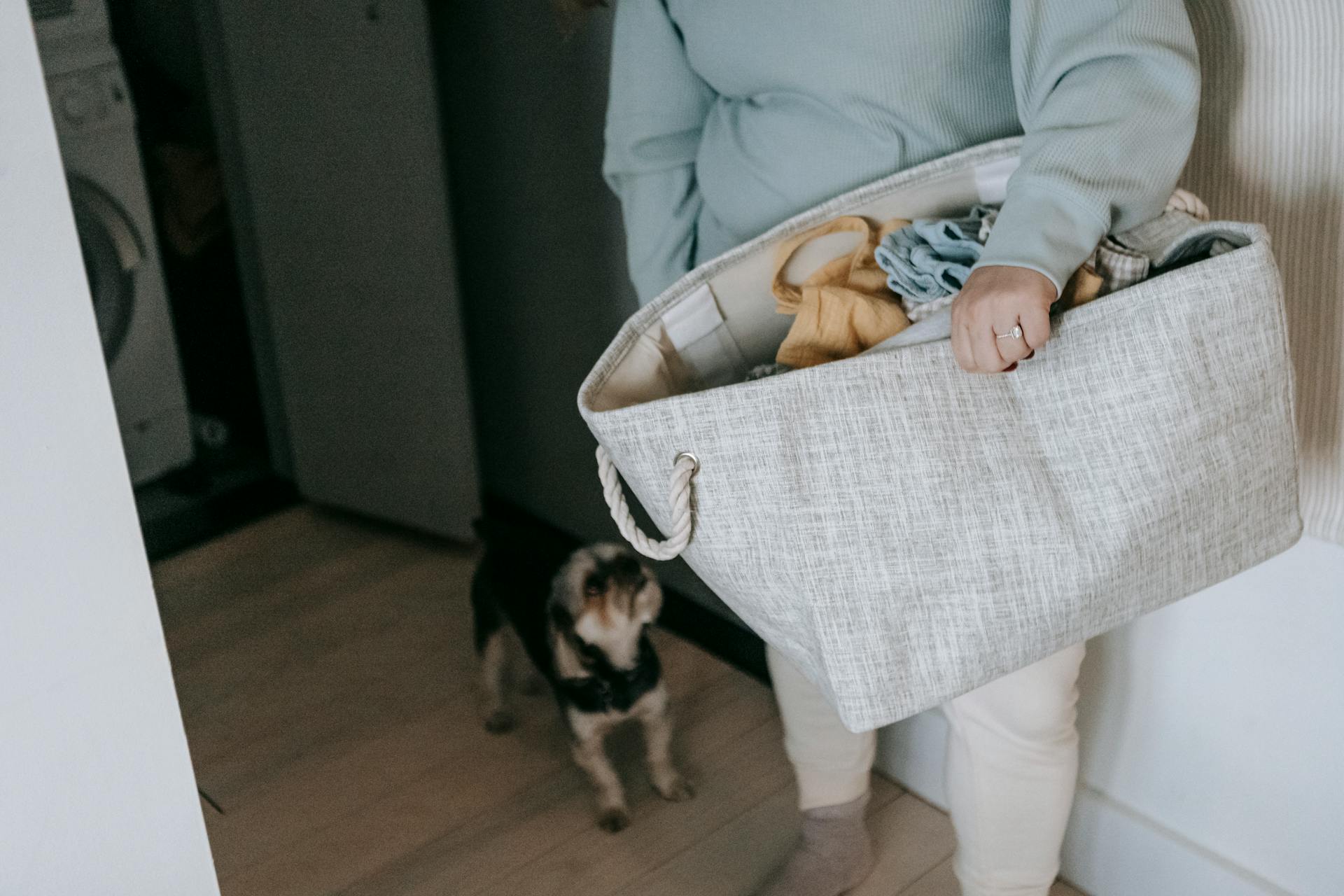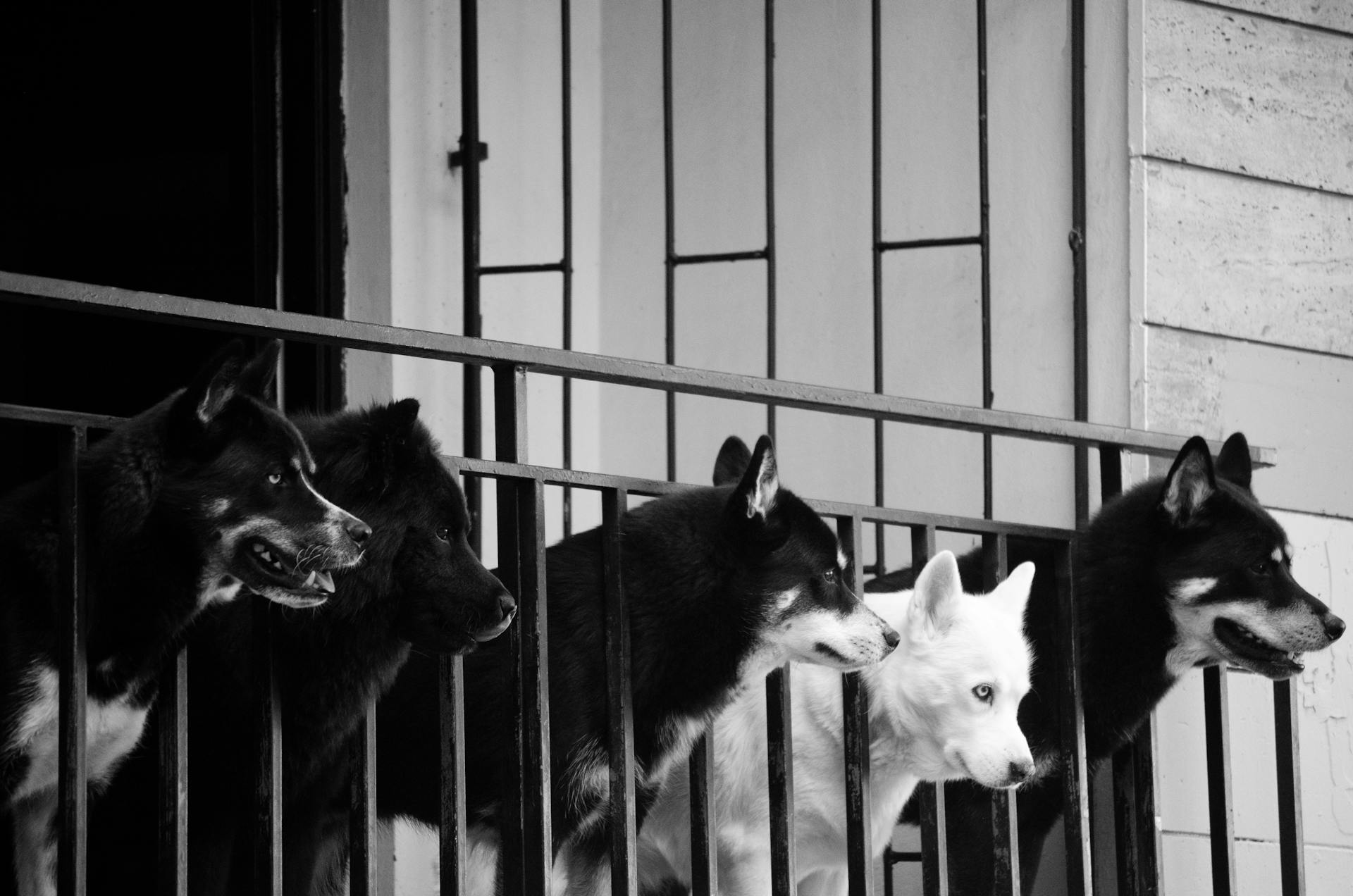
Dogs eating tampons can be a serious issue, and it's essential to understand the risks and take preventative measures.
Tampons are not digestible and can cause intestinal blockages or punctures if ingested.
Dogs may be attracted to the smell or texture of tampons, which can lead to accidental ingestion.
According to the ASPCA, it's estimated that up to 10% of dogs will ingest a non-food item at some point in their lives.
If you suspect your dog has eaten a tampon, it's crucial to seek veterinary attention immediately.
The symptoms of intestinal blockage or puncture can be severe and may include vomiting, diarrhea, abdominal pain, and lethargy.
Preventing your dog from accessing tampons in the first place is the best course of action.
Risks and Consequences
Dogs eating tampons can be a serious issue, and it's essential to understand the risks and consequences involved.
If your dog swallows a tampon, it can cause intestinal blockage, which can be excruciatingly painful and even life-threatening. This can lead to necrosis, or tissue death, which presents a litany of potential complications.
The size of your dog plays a significant role in determining the risk. Larger dogs have larger intestinal tracts, making it easier for them to pass tampons and other eaten items. In contrast, smaller dogs like pugs are more likely to be in danger.
Unused tampons are especially hazardous because they can absorb digestive juices and expand, leading to intestinal blockage. Used tampons, on the other hand, are less likely to cause an intestinal obstruction due to the blood present in them.
If your dog eats a tampon, watch for symptoms like distress, panic, suffering, pawing at the mouth, rubbing their face on the ground, hypersalivation, coughing, gagging, and/or retching, and blue gums (cyanosis). If you notice any of these signs, contact your veterinarian immediately.
Here are some factors that can affect the relative danger posed by a tampon-eating dog:
- Your dog’s size.
- The contents of your dog’s digestive tract.
- The number of tampons he consumed.
Poisoning
Poisoning is a serious risk if your dog ingests a tampon. Chemicals, additives, or fragrances in tampons can be toxic to dogs.

Symptoms of poisoning can manifest as nausea, vomiting, and diarrhea. These chemicals could also trigger severe allergic reactions in some dogs.
Unused tampons are particularly hazardous because they will swell in your dog's throat or stomach, making them difficult to remove or pass. This can lead to serious complications, including intestinal blockage.
Here are some signs that your dog may be experiencing poisoning or other complications:
- Distress
- Panic
- Suffering
- Pawing at the mouth
- Rubbing their face on the ground
- Hypersalivation
- Coughing, gagging, and/or retching
- Blue gums (cyanosis)
Tampon Expiration Risks
Unused tampons can be especially hazardous, as they're designed to absorb more liquid than used ones. This can lead to a life-threatening intestinal blockage in dogs.
High absorbency tampons are particularly problematic, as they can swell in size and density in the digestive tract, robbing the dog of vital fluids.
The string attached to a tampon can cause serious damage if it becomes tangled or tears away at the lining of the esophagus or intestines.
Is My Life in Danger?
If your dog has eaten a tampon, there's a good chance they'll be okay, but it's essential to be aware of the potential risks. The likelihood of your dog passing the tampon with no issues depends on various factors.

Larger dogs have a larger intestinal tract, making it easier for them to pass tampons and other eaten items. In contrast, smaller dogs like pugs are more likely to experience problems.
The contents of your dog's digestive tract can also impact the situation. If your dog has eaten a used tampon, the blood present may cause the cotton to distend, which can actually reduce the risk of an intestinal obstruction.
If your dog has eaten multiple tampons, the risk of an intestinal blockage increases significantly. It's crucial to determine how many tampons your dog has consumed to assess the situation accurately.
Here's a rough estimate of the time it may take for symptoms to appear:
Keep in mind that not all dogs will experience problems after eating a tampon. Some may pass it with no issues, but it's always better to err on the side of caution and seek veterinary attention.
Prevention and Safety
Keeping your bathroom trashcan out of reach is a simple yet effective solution to prevent your dog from getting into tampons. Just keep the bathroom door closed at all times.
You can also use a pet-proof trashcan with an automatically closing lid that's difficult for pets to lift. The simplehuman Trash Can is a good option for bathroom use.
Bagging used tampons in a zipper-style plastic bag can also deter your dog from investigating the trashcan.
Choking
Choking is a serious and potentially life-threatening situation for dogs. If a dog swallows a tampon whole, there's a possibility that it gets stuck within the esophagus.
The possibility of choking depends on the size and texture of the tampon and the dog's size. Small dogs that swallow tampons are more prone to choking than larger breeds.
If you see your dog choking, open their mouth gently to avoid getting bitten and try to see the tampon. Don't insert your hand without seeing the object because you risk pushing the tampon even farther into your dog's throat and making them suffocate.
Extract the tampon if you see it, as this can save your dog's life.
Tampon Safety: Used vs Unused

Unused tampons are especially dangerous because they can absorb digestive juices and expand, leading to intestinal blockage.
The main risk with new tampons is that they can absorb digestive juices and expand, leading to intestinal blockage.
Used tampons also pose significant risks if ingested by dogs, but the danger lies in the potential for the string to become tangled or tear away at the lining of the esophagus or intestines.
The tiny string attached to a tampon can cause serious damage, and potentially be the most dangerous part, if it becomes tangled or tears away at the lining of the esophagus or intestines.
Both used and unused tampons are equally hazardous if ingested by dogs, so it's crucial to keep them out of reach.
Tampon Use and Disposal
Used tampons can be just as hazardous as unused ones if ingested by dogs, as they can absorb digestive juices and expand, leading to intestinal blockage.

It's essential to keep your bathroom trashcan out of your dog's reach to prevent them from eating used tampons or other unwanted items.
Spraying a little dog repellent around the rim of the trashcan can help deter your dog from investigating it. Four Paws Keep Off! Spray is a good choice for this purpose.
Using a pet-proof trashcan with an automatically closing lid is another effective way to keep your dog out of the bathroom trashcan. The simplehuman Trash Can is a great option for bathroom use.
Bagging used tampons before discarding them can also help prevent your dog from getting into them. Place used hygiene products in a zipper-style plastic bag to make them less appealing to your dog.
Keeping Out of the Bathroom Trashcan
Dogs are naturally curious animals with a heightened sense of smell, which can lead them to eat weird things, including tampons, due to their fascinating scent and potential snack-like appearance.

Keep your bathroom shut at all times to prevent your dog from accessing the trashcan. This simple solution can be effective in preventing the practice.
Dogs can't resist the stench of decaying materials or bodily fluids like blood and discharge, which is why they're drawn to the bathroom trashcan in the first place.
Spray a little dog repellent around the rim of the trashcan, such as Four Paws Keep Off! Spray, to deter your dog from approaching the area.
Using a pet-proof trashcan with an automatically closing lid can be an effective solution, as it's difficult for pets to lift the lid and access the contents.
Bag used tampons before discarding them in a zipper-style plastic bag to prevent your dog from smelling them and getting into trouble.
What to Do
If your dog is choking on a tampon, it's essential to act fast.
Opening your dog's mouth gently is crucial, making sure you don't get bitten in the process.
The object blocking their airways can kill them, so it's vital to extract the tampon as soon as possible.
Don't insert your hand without seeing the object, as this can push the tampon further into their throat and cause suffocation.
Assess the Situation
When your dog gets into something it shouldn't, it's essential to assess the situation quickly and accurately.
First, figure out if your dog ate a used or unused tampon. This information is crucial for your veterinarian to decide on the best course of action.
You'll also need to determine how many tampons your dog ingested. This detail can help your vet determine the severity of the situation and the necessary treatment.
Choking Relief
Choking can be a serious issue if your dog swallows a tampon whole, and it's more likely to happen with small dogs that have a smaller esophagus.
The size and texture of the tampon also play a role in whether it gets stuck, so it's essential to be aware of these factors.
If your dog starts choking, you need to act fast to prevent suffocation.
Gently open your dog's mouth to see if you can spot the tampon, making sure not to get bitten.
Don't insert your hand without seeing the object, as this can push the tampon further into your dog's throat and make things worse.
If you do see the tampon, carefully try to extract it to relieve your dog's airways.
Symptoms and Emergency
If your dog has eaten a tampon, it's essential to recognize the symptoms of illness that can occur. Excessive drooling, difficulty swallowing, and loss of appetite are all possible signs.
You may also notice changes in your dog's bowel movements, such as constipation or diarrhea. Lethargy, vomiting, and abdominal pain are other symptoms to watch out for.
Some dogs may not show any noticeable symptoms at all, but if you suspect your dog has eaten a tampon, it's always better to err on the side of caution and seek veterinary assistance. If your dog is showing any of these signs, it's crucial to get them to the vet as soon as possible.
Here are some common symptoms to look out for:
- Vomiting
- Diarrhea
- Abdominal pain
- Lack of appetite
- Halitosis (bad breath)
- Increased salivation
- Abnormal body positions
- Constipation
- Retching or dry heaving
Keep in mind that the symptoms can vary depending on the location of the tampon in your dog's digestive system. If your dog is showing any of these signs, it's essential to seek veterinary assistance to prevent further complications.
Frequently Asked Questions
What if my dog eats a cotton pad?
If your dog eats a cotton pad, check their feces for the pad within 48 hours and seek veterinary attention if it's not found or if your dog shows signs of lethargy, vomiting, or digestive issues
Featured Images: pexels.com


